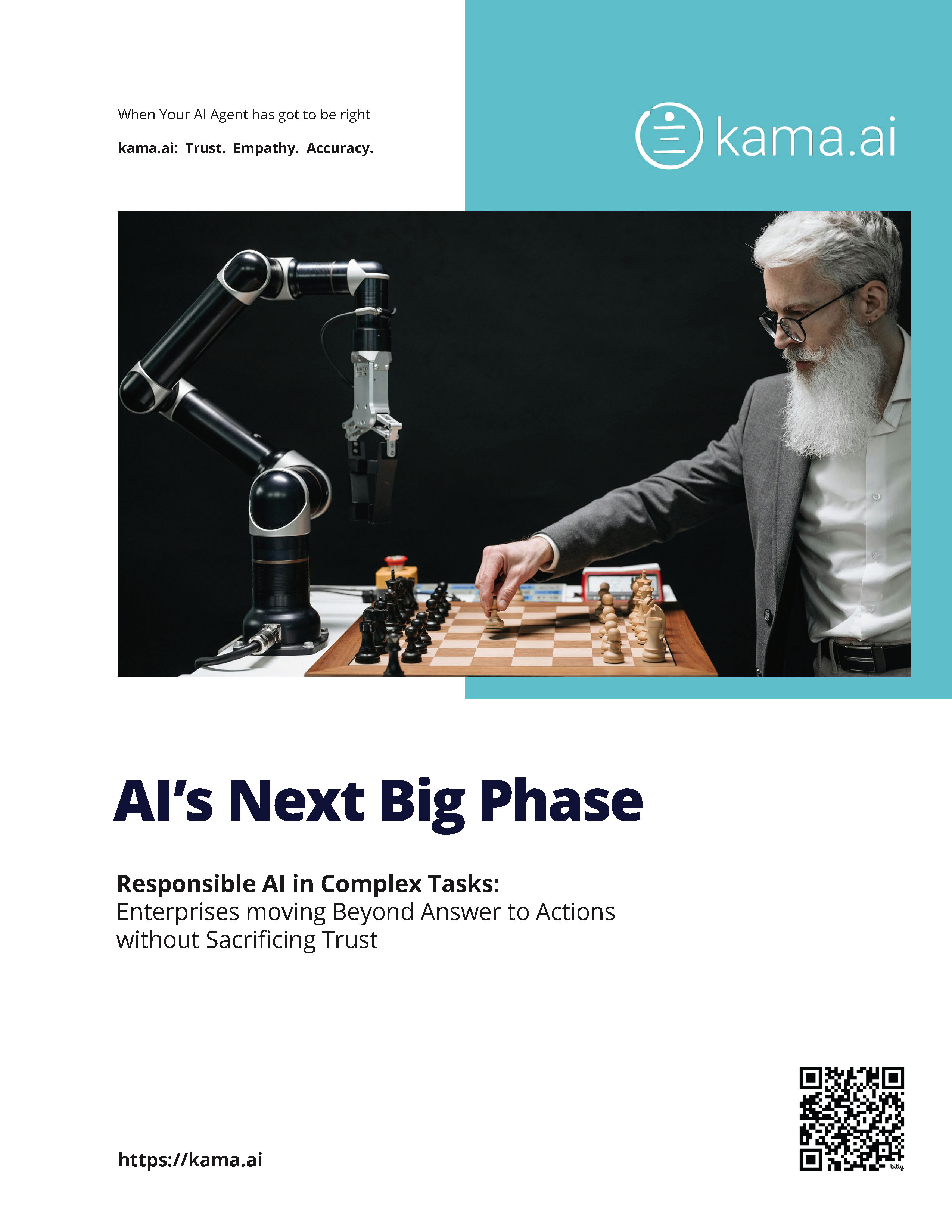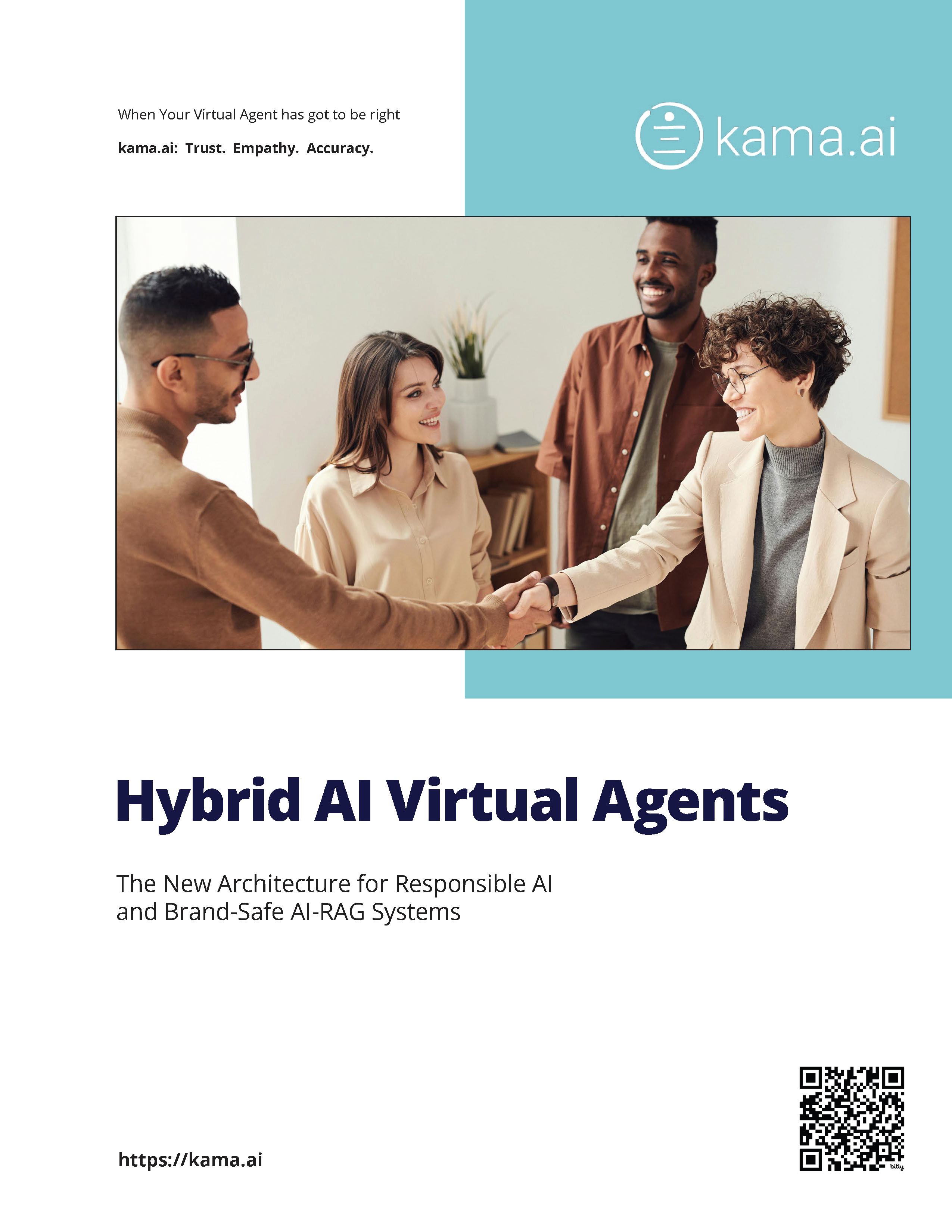
Listen to this blog
Trust Matters: Especially when AI Answers become AI Actions
We are at a major evolutionary point in AI technologies. It has happened at a record breaking speed. We are just getting started with using systems that provide AI answers to our questions, and create art, essays, and videos. Now we are starting to see true AI agent solutions coming out of the generative AI engines. In other words, systems like ChatGPT and Gemini are now able to run complex tasks, and orchestrate automation across various systems. We are evolving from purely answering questions to executing tasks. As such the stakes have risen.
A wrong answer is one thing. But a wrong action, especially in enterprise environments, can cause real harm. That’s why accuracy and trust, not just speed or fluency, must sit at the center of enterprise AI adoption. Responsible AI becomes key to this new realm.
In this new landscape, responsible Hybrid AI offers a compelling path forward. These systems (like kama.ai’s) bring together deterministic accuracy, governed generative AI (GenAI), and robotic process automation (RPA) to move beyond chat. When AI answers trigger downstream actions – like updating an insurance policy, changing investment choices, or adjusting employee benefits – getting it right is non-negotiable.
Trust Matters: Especially when AI Answers become AI Actions
We are at a major evolutionary point in AI technologies. It has happened at a record breaking speed. We are just getting started with using systems that provide AI answers to our questions, and create art, essays, and videos. Now we are starting to see true AI agent solutions coming out of the generative AI engines. In other words, systems like ChatGPT and Gemini are now able to run complex tasks, and orchestrate automation across various systems. We are evolving from purely answering questions to executing tasks. As such the stakes have risen.
A wrong answer is one thing. But a wrong action, especially in enterprise environments, can cause real harm. That’s why accuracy and trust, not just speed or fluency, must sit at the center of enterprise AI adoption. Responsible AI becomes key to this new realm.
In this new landscape, responsible Hybrid AI offers a compelling path forward. These systems (like kama.ai’s) bring together deterministic accuracy, governed generative AI (GenAI), and robotic process automation (RPA) to move beyond chat. When AI answers trigger downstream actions – like updating an insurance policy, changing investment choices, or adjusting employee benefits – getting it right is non-negotiable.

Listen to this blog
The Consequences of Actionable AI
The first wave of GenAI made AI accessible and impressive. It talked. It summarized. It created. But the downside became quickly apparent. A 2024 Oxford study found that GenAI hallucinated in 58% of test cases. And McKinsey reported that nearly half of companies had already experienced real-world consequences from GenAI errors. When users start acting on this information—automatically or manually—those consequences compound.
Enterprise AI is no longer just about support or surface-level queries. It’s now integrated into mission-critical systems and workflows. These systems may interact with health records, financial accounts, or compliance processes. If an AI-generated answer leads to an inaccurate action, the liability—and cost—can be enormous. This shift makes governance, transparency, and oversight mandatory.
 A New Foundation: Verified AI Answers
A New Foundation: Verified AI Answers
Modern Hybrid AI frameworks begin by separating known facts from generated content. They start with deterministic Knowledge Graphs—systems that only return verified, human-reviewed information. This means if a user asks a question that has been structured and approved by domain experts, they get a guaranteed accurate answer.
But if the answer isn’t in the graph? The system shifts to a secondary, governed mode—GenAI working from a Trusted Collection of internal documents. Even then, the user is warned: this answer was generated by AI and should be double-checked. This layered model means organizations can scale AI confidently, without guessing what the AI will say next.
As stated in the full eBook, “The world does not need faster AI. It needs AI that is smarter, safer, and trustworthy.” Read more in the full eBook.
Trustworthy Systems for High-Impact Tasks
Imagine you’ve just had a child and need to update your benefits plan. A conversational chatbot handles the request. But the system it runs on does more than just offer advice—it authenticates you, checks your current plan, interfaces with HR systems, contacts the benefits provider, updates payroll, and sends a confirmation email with a digital signature request.
In such a case, a hallucinated response or minor misjudgment can trigger costly errors. This is not theoretical. Hybrid AI can—and does—handle such multi-step processes today. It must operate with deterministic accuracy and guided GenAI safeguards to ensure that what’s executed reflects policy, compliance, and brand tone.
This is where “AI Answers” evolve into enterprise actions. It’s no longer a tool—it’s a digital workforce. And that workforce must follow the rules.
Governance Is the Differentiator
Responsible AI requires governance, not just guardrails. It means knowing when AI was used, what data it accessed, and how it came to a conclusion. It means audit logs, disclaimers, and human-in-the-loop reviews when content goes beyond approved knowledge.
The kama.ai Hybrid AI architecture leverages containment—preventing any use of open-web content. It ensures that GenAI is only engaged in controlled, pre-approved scenarios. And it demands traceability—every answer, every action, and every interaction is recorded. This isn’t optional. This is the baseline for responsible enterprise use.
McKinsey’s report underscores this, stating that 86% of organizations report increased productivity after adopting RPA—but only 17% attribute more than 5% EBIT impact to GenAI so far. That’s because true transformation only happens when trust is built into the system. Read more in the full eBook.
Where Action Requires Accountability
It’s one thing to ask about the weather. It’s another to allow an AI system to cancel your travel plans, update your pension allocation, or change your legal document preferences. The deeper AI moves into enterprise actions, the more trust, governance, and alignment with brand values matter.
That’s why Hybrid AI isn’t just a technical solution—it’s a strategic necessity. It offers enterprises a framework for safe execution, layered trust, and scalable automation. When AI is tasked with action, not just answer, responsibility must be built-in—not bolted on.
Trust Is the New KPI
The AI adoption curve won’t slow down. But it must mature. Enterprise teams deploying AI in sensitive use cases must start with trust. That means rejecting black-box models. It means investing in explainability, auditability, and oversight. It means asking: Can we trust this AI to take action? If not, we’re not ready.
At kama.ai, we believe in building AI that does more—safely. If your enterprise is ready to move beyond chat and toward action, start with trust. Let’s build it, together.
